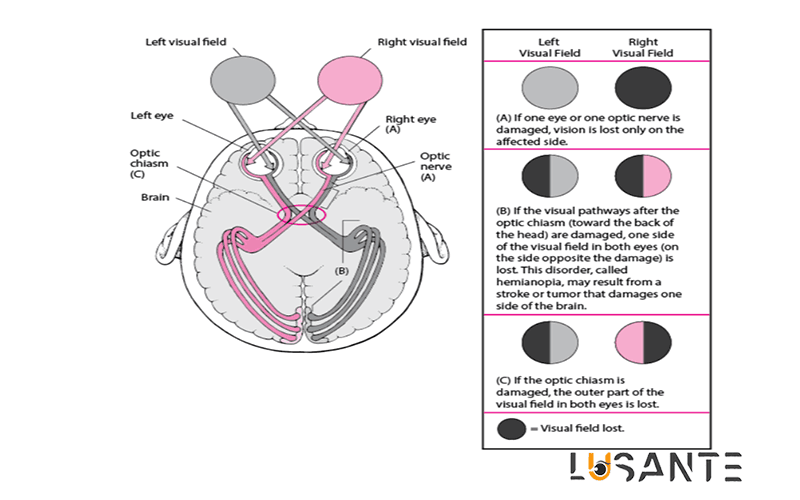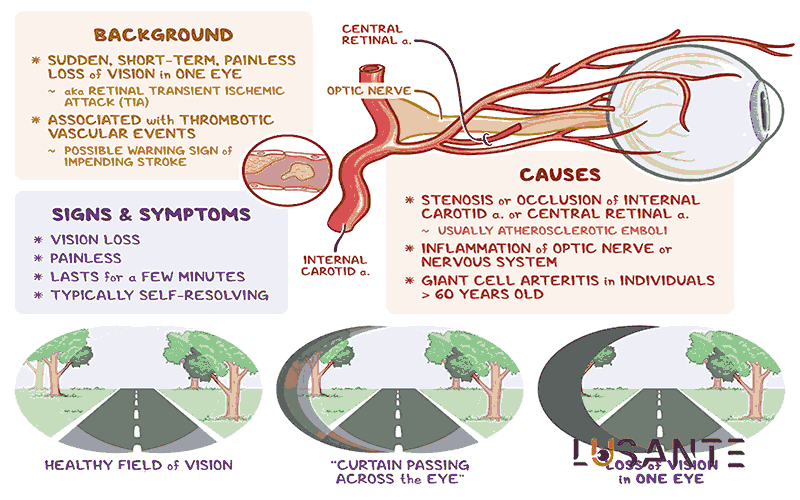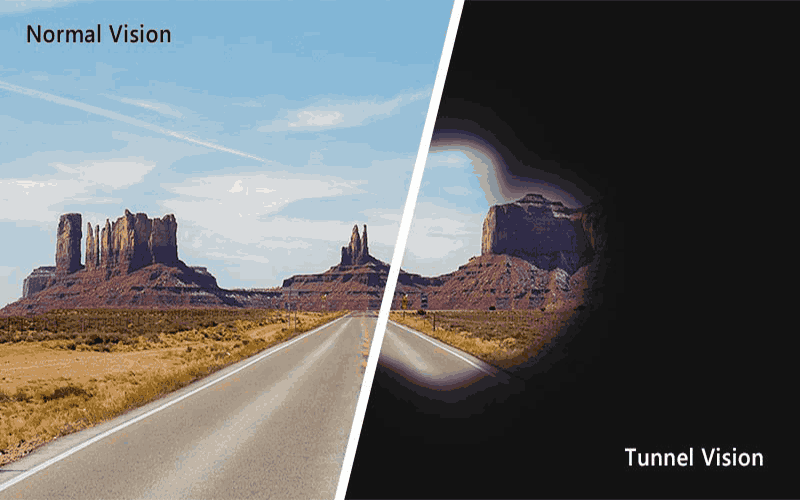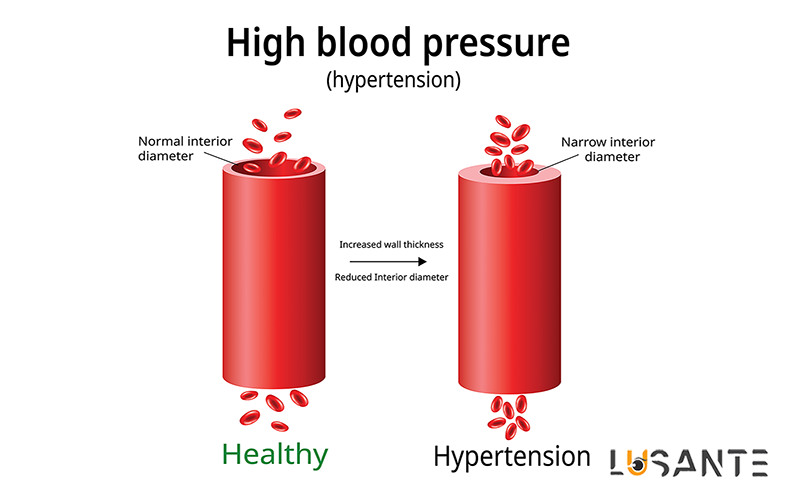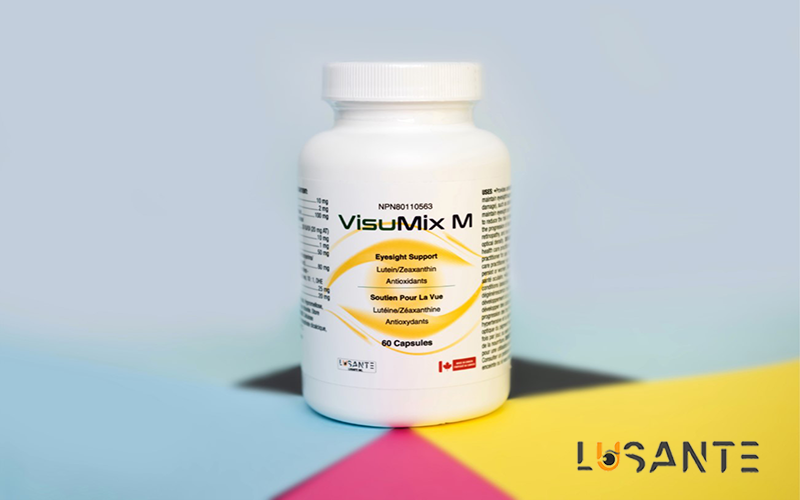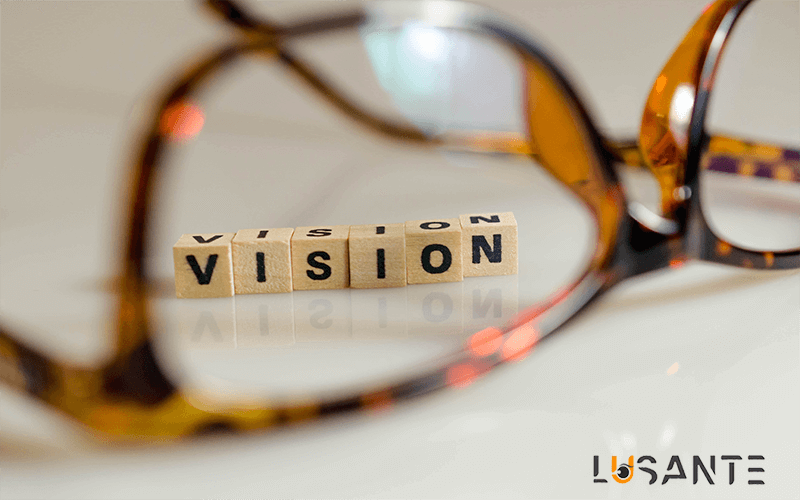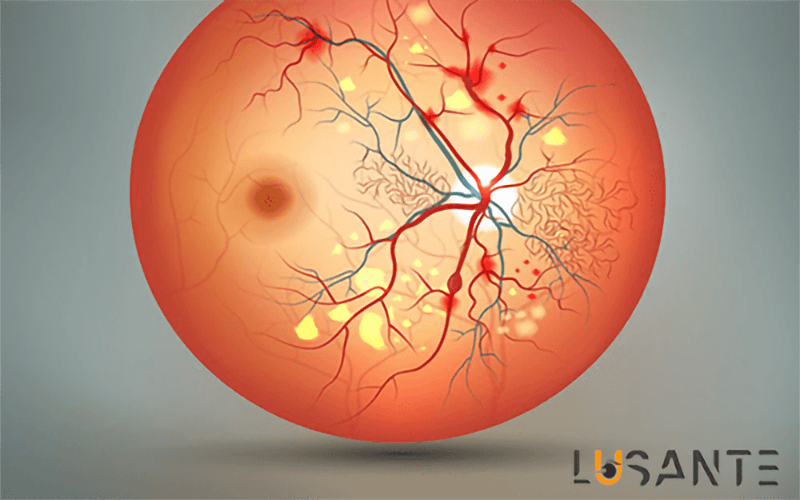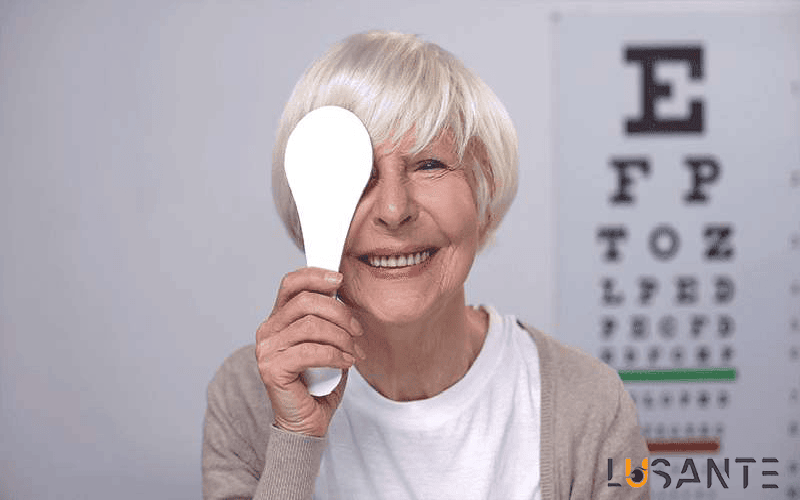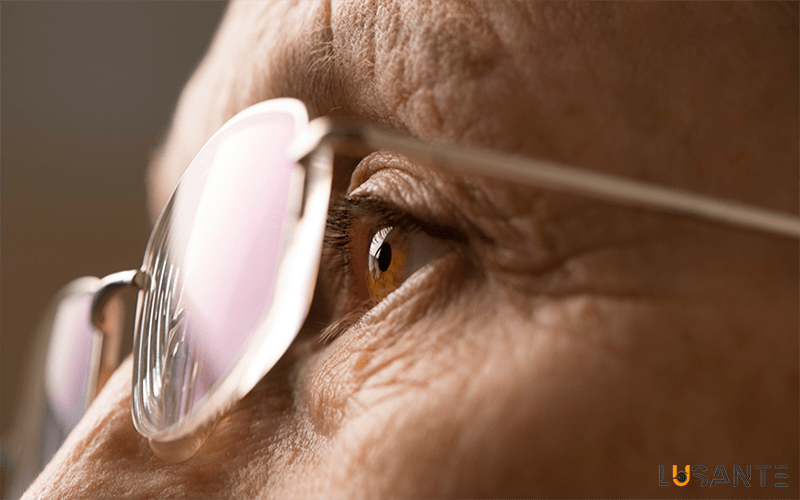Which Supplement Helps to Prevent Diabetes And Vision loss? | 5 Certain Method To Reduce
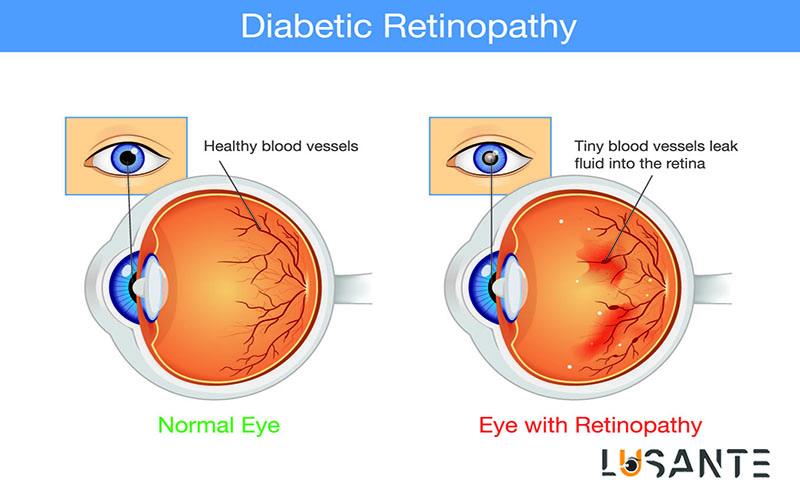
When does diabetes occur?
Diabetes And Vision loss can influence each other. To better control it, we need to know what diabetes is. Diabetes occurs when the body is not able to produce enough insulin hormone or for some reason, the effect of the produced insulin has been decreased. Insulin is regulated in the body by the foods a person eats.
The body of diabetics is not able to regulate the amount of sugar and other carbohydrates needed in the usual way . Global statistics show that nearly 1 out of 25 people have diabetes, while it is higher in South Asia.
Many factors are involved in getting this disease, including genetic factors, nutrition, overweight (weight ↑), and lack of enough exercise.
Some children also get diabetes, but this disease often starts at an older age. Diabetes can cause problems in different parts of the body, including the eyes. There are two main types of diabetes, commonly known as type 1 and type 2 diabetes.
Type 1 diabetes: This type of diabetes usually starts before the age of 30 and occurs because of a lack of production or low production of insulin. Type 1 diabetes is usually controlled by insulin injections, so it is called insulin-dependent diabetes.
Type 2 diabetes: This type of diabetes usually starts after the age of 40. In this type of diabetes, the body produces some insulin, but this amount is either insufficient or the body is unable to use it properly. Type 2 diabetes is usually controlled by diet, exercise, or medication. Although some people in this group may need insulin injections. This type is usually known as non-insulin-dependent diabetes.
Gestational diabetes: This type of diabetes usually occurs during the second or third trimester of pregnancy and in most cases, it resolves after the end of pregnancy, but it increases the possibility of developing type 1 and 2 diabetes in later years of life.
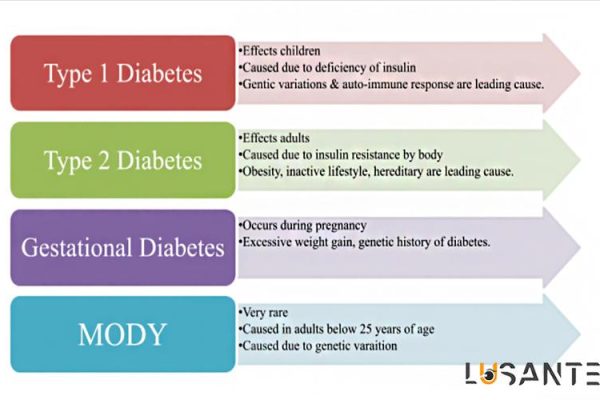
Diabetes And Vision loss; The Eye Function:
When you look at an object, light passes through the front part of the eye and is focused on the retina by the cornea and lens. The retina is a delicate tissue that is sensitive to light and transmits light in the form of electronic signals to the brain through the optic nerve.
The brain analyzes these signals to “see” the surrounding world. The retina is nourished by a delicate network of blood vessels. These blood vessels may be damaged by diabetes; So this is how Diabetes And Vision loss are related to each other.
Light entering the eye is focused on a thin area in the center of the retina called the macula. The size of this extremely sensitive area of the retina is about the size of a pinhead and it is very vital in terms of allowing a person to see fine details in activities such as reading and writing and distinguishing colors.
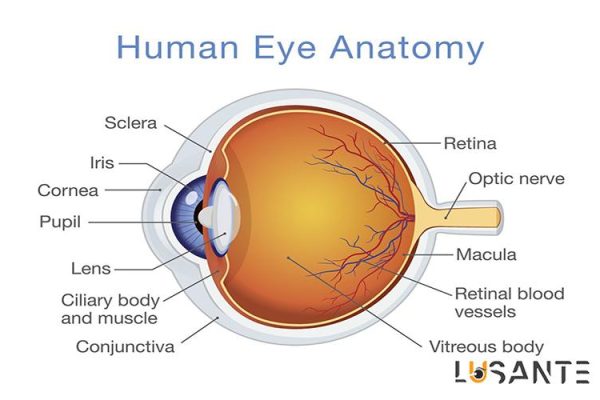
Diabetes And Vision loss; Eye complications of diabetes and its impact on vision
Diabetes can affect the eyes in several ways. As we know, Diabetes And Vision loss affect each other to some extent.
-
Diabetes And Vision loss; Diabetic retinopathy
The most serious eye complication related to diabetes is the involvement of the network of blood vessels feeding the retina, this condition (disease) is called diabetic retinopathy.
At the early stage of diabetic retinopathy, the vision is normal, and the person does not have visual complaints, but if it progresses, it can cause blockage of blood vessels in the retina. In this case, the neovascularization process occurs in which the eye is stimulated to create and grow new vessels.
Unfortunately, The effect of Diabetes And Vision loss on each other causes these new blood vessels are very weak and grow in inappropriate areas (on the surface of the retina and inside the vitreous), as a result, these blood vessels can easily cause severe bleeding on the surface of the retina or inside the vitreous.
This type of bleeding can completely obscure vision since the bleeding blocks the light. In many people, over time, the blood can be absorbed and their vision will improve.
But in the other group, bleeding may occur frequently and the blood may not be completely absorbed. This condition leads to permanent vision loss.
Extensive bleeding can form scar tissue, which causes the retina to stretch and become irregular. This type of advanced diabetic eye involvement can lead to retinal detachment and increase the risk of vision loss.
Only 5-10% of all people with diabetes develop advanced retinopathy. This condition is more common in people with type 1 diabetes. 60% of people with type 1 diabetes show some symptoms of advanced retinopathy after 30 years of diabetes onset.
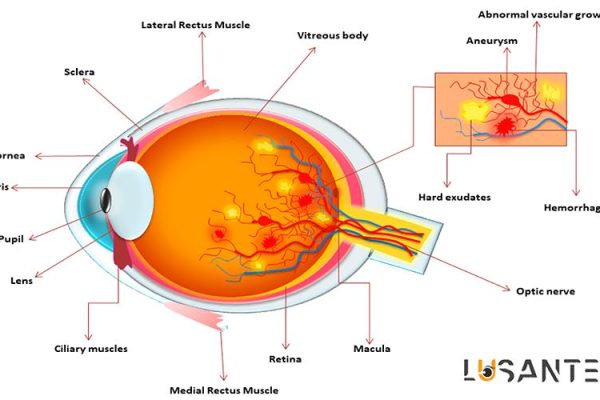
-
Diabetes And Vision loss; Diabetic Maculopathy
Diabetic Maculopathy means the central area of the retina called the macula is affected by diabetes.
In this case, the person may have trouble seeing details such as recognizing people’s faces at a distance or fine writing. The degree of central vision loss varies from person to person. However, peripheral vision is not affected. Diabetic maculopathy is often treated with lasers and injectable medications (to prevent worsening vision while possible), and vision may improve in some cases. Using this method, Diabetes And Vision loss might be controlled.
- Abnormal changes in blood sugar levels caused by diabetes can affect the intraocular lens, especially when diabetes is uncontrolled. This can lead to occasional blurred vision throughout the day, depending on blood sugar levels.
- A longer-term effect of diabetes on the lens inside the eye is the clouding of the lens, known as cataracts. These eye problems and complications may not occur in all people with diabetes, and many of the people who have eye complications due to diabetes have mild retinopathy, and vision may never be affected.
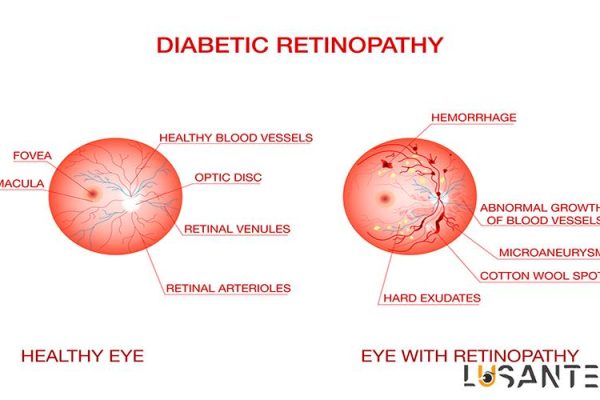
Diabetes And Vision loss; Reducing the risk of eye problems related to diabetes
The risk factors for developing diabetic retinopathy are directly dependent on diabetes management and control activities.
The following activities reduce the risk of developing retinopathy, Diabetes And Vision loss or help prevent retinal deterioration.
- Blood sugar control (glucose level)
2. Accurate control of blood pressure
3. Cholesterol level control
4. Strict weight control and smoking cessation. The possibility of nerve damage, knee problems, and cardiovascular diseases is much higher in smokers with diabetes. Smoking increases blood pressure and raises blood sugar, which makes diabetes harder to control.
5. Screening and regular retinal examination. The most effective thing a person can do to prevent vision loss from diabetic retinopathy is a regular schedule of retinal examinations. Early diagnosis and treatment can prevent vision loss.
Related Product: VisuMix M
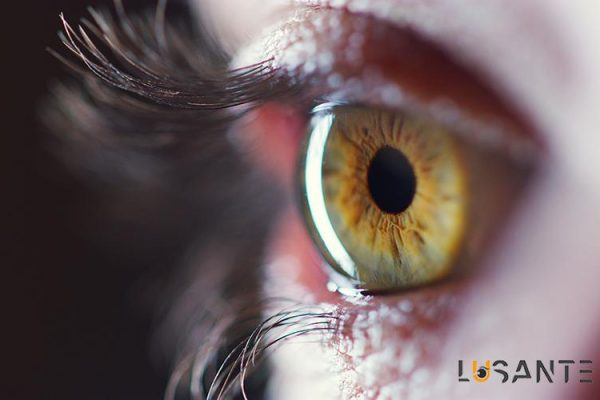
•Diabetes And Vision loss; Risk factors that cannot be controlled
- The length of time a person has diabetes. This is a major risk factor for developing diabetic retinopathy.
- Age that affects the development of diabetic retinopathy.
- Race (the risk of developing diabetes and eye problems related to diabetes is higher in families with Indian, Pakistani, Bangladeshi, or Sri Lankan race.)
- Women with diabetes should consult a doctor before pregnancy and have regular retinal examinations during pregnancy. And if a person is diagnosed with gestational diabetes, regular retinal examinations during pregnancy and after the birth of the baby are necessary.
•Diabetes And Vision loss; Annual Eye examinations for diabetes
Vision is not necessarily affected in diabetics. If diabetes is well controlled, the chances of occurring complications or serious problems are reduced.
Although there is a possibility of severe vision loss, most of the eye problems caused by diabetes can be treated, but the crucial point is early detection.
If you have diabetes, annual eye exams scheduled by your doctor are required. For this purpose, eye drops are dripped into the eye, which dilates the pupil for a precise retinal examination.
Sometimes retinal imaging may indicate the details if any changes occur due to diabetes. If you have diabetes, even if you haven’t had any special eye problems, having these regular periodic examinations is very necessary to control diabetes and vision loss.
Studies show that if retinopathy is detected early (during retinal screening examinations) and treated appropriately, it can prevent 90% of blindness.

Diabetes And Vision loss; Treatment of diabetic retinopathy
Most of the vision problems caused by diabetic retinopathy can be controlled and treated with laser therapy if diagnosed early. The goal of laser treatment is to prevent bleeding or the growth of new blood vessels in the retina.
A. Diabetes And Vision loss; Laser treatment
- Localized laser treatment: this laser method can be used to stabilize vision by trying to stop damaged blood vessels from leaking in order to help slow down or reverse retinal edema. This type of treatment is quick and only takes a few minutes. Localized laser therapy is also used when maculopathy is diagnosed. The side effects are rare in this treatment method because it only affects a very small area of the retina.
2. General or pan-retinal laser treatment: when the growth of new blood vessels (neovascularization) is detected in the examination, wider laser treatment may be needed.
The goal of this method is the treatment of large areas of the retina with a laser. This treatment prevents the creation of stimulating factors for the growth of new blood vessels in the retina (diabetes and vision loss).
If the treatment is successful, the new vessels will shrink and disappear after a few months. But since large areas of the peripheral retina are subjected to laser treatment, It may significantly affect a person’s vision.
Therefore, the permanent loss of some side vision (peripheral vision) is quite common, and this can interfere with a person’s ability to drive, especially at night, and a person’s color vision.
At the initial stage of detection of new vessels, the person’s vision may be good with no significant vision problems. It can be explained that, in the early stages, the new vessels have very little effect on vision.
After the treatment, peripheral vision may be very poor. A person may feel that the laser has weakened his vision.
Despite all these consequences, If a patient abandons the treatment, the new vessels will soon bleed and cause a severe loss of vision. It should be noticed that the goal of laser treatment is to prevent the deterioration of vision and it cannot improve vision.
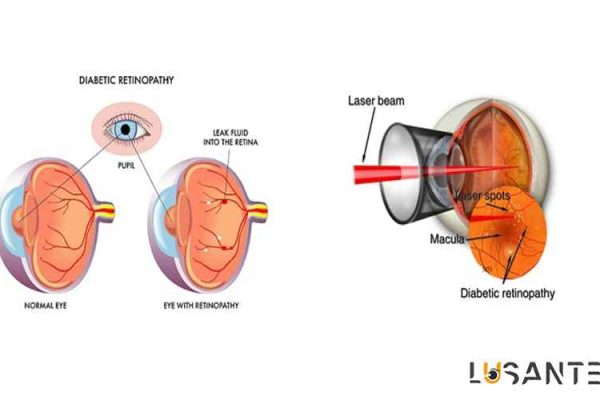
Common questions about Laser treatment:
Are these laser treatments painful?
To control diabetes and vision loss, topical or localized treatment usually does not cause discomfort and pain, but pan-retinal laser treatment can cause discomfort and pain and the patient may need eye drops simultaneously.
Does laser treatment have side effects?
There is no treatment with no side effects. To prevent diabetes and vision loss
the risks of doing laser treatment are much lower than not doing it.
The short-term effects of laser treatment are caused by the brightness of the laser used, which can cause a temporary decrease in vision between 1-2 hours after the treatment.
It may also cause a slight decrease in the person’s central vision, which improves over time and leads to the after-effects of the laser, such as small black dots in the person’s field of vision.
Local treatment has few long-term effects because it only treats a small area of the retina, however, more extensive pan-retinal treatments can have lasting effects on a person’s vision.
- Some reduction in peripheral vision is quite normal and this may affect a person’s ability to drive, especially at night, as well as a person’s color vision.
- The person’s central vision may not be as good as before, for example, printed letters cannot be seen easily.
The possible side effects of the treatment depend on the condition of the person’s eyes and the type of treatment that the specialist suggests.
Ask your doctor to explain to you the treatment method, the advantages and disadvantages of the treatment, and the possible side effects. After laser treatment, you need a detailed eye examination and determination of central and peripheral vision to ensure you are able to drive.
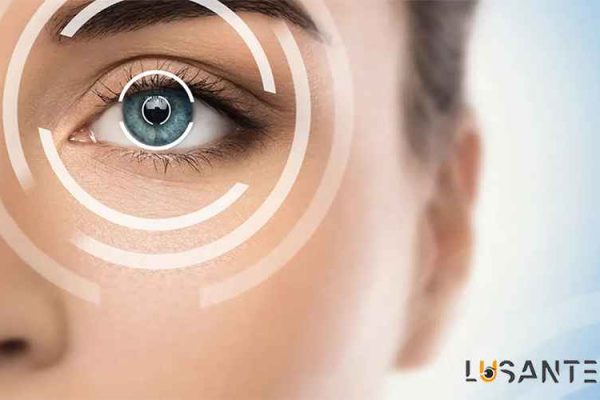
The importance of early (primary) treatment
Although your vision may be fine, there may be changes in the retina that require treatment. Most of the vision loss caused by diabetes (diabetes and vision loss) can be prevented if the treatment is done in time. The faster and sooner the treatment is done, the more effective it will be.
If the eyes hurt after treatment or the person’s vision worsens:
After general laser treatment, most people get headaches, so headache pills are usually prescribed. But if the pain is severe or the person’s vision worsens, he should see a specialist immediately.
Diabetes And Vision loss; Treatment of diabetic macula
Diabetes can cause the accumulation of fluid under or on the macula (the center of vision in the retina), which leads to inflammation of the macula, which is called edema in medical terms. Diabetic macular edema may cause central vision impairment or blurring (Diabetes And Vision loss).
If the edema does not involve the center of the macula (or fovea), laser treatment can reduce the leakage and prevent blurred vision. But if the edema has affected the center of the macula, laser treatment is useless in improving vision loss.
There are some treatment methods for this type of macular edema.
Lucentis is an anti-vascular growth factor (Anti-VEGF) that can reduce macular edema and improve a person’s central vision. The function of Anti-VEGF drugs is based on blocking the effects of growth factor (VEGF), which is involved in the formation and leakage of blood vessels. Anti-VEGF drugs stop the growth of new blood vessels and help reduce macular edema.
In this type of treatment, Lucentis is injected into the white of the eye and may require more than one injection in monthly periods to achieve the best effect.
There are some limitations to using Lucentis in diabetic macular edema based on the extent of the edema’s effect on the macula. The attending physician can decide on the appropriateness of this treatment method for a person’s eyes.
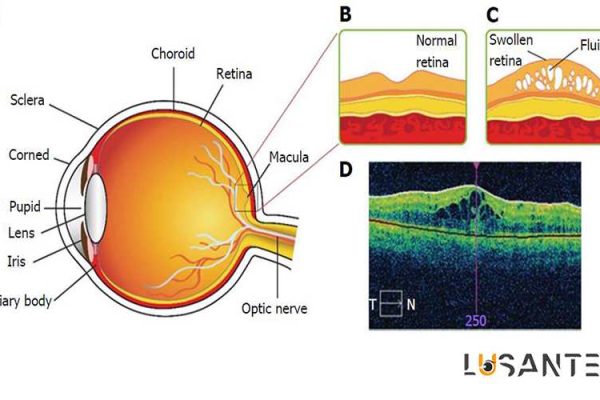
Other effects of diabetes on the eyes
The temporary (transient) blurring of vision: in diabetics, changes in blood sugar levels can affect the intraocular lens, especially in uncontrolled diabetes. This can lead to transient (occasional) blurring of vision during the day.
This blurring can be one of the early symptoms of diabetes and may occur any time blood sugar is not controlled. (The effect of diabetes and vision loss) If diabetes is controlled, this transient blur will not occur.
Cataract: Cataract refers to the clouding of the lens inside the eye, and since light cannot easily pass through the lens and reach the bottom of the eye, the person’s vision becomes blurred.
This condition is one of the most common eye diseases that often occur in older age, but in diabetic people, it sometimes occurs at an early age. To treat cataracts, the cloudy lens of the eye is surgically removed and replaced with an artificial lens called an IOL.
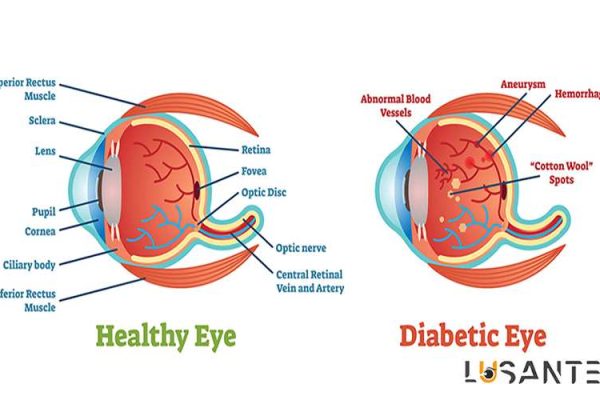
Important points to remember:
- Early diagnosis of diabetic retinopathy is highly important.
- A regular and periodic eye examination is recommended.
- Remember that even if your vision worsens over time, it does not necessarily mean that you have diabetic retinopathy. This may have a simple cause such as a change in your eye number, which can be resolved by prescribing new glasses.
- Controlling blood sugar, blood pressure and cholesterol can help reduce the risk of eye problems related to diabetes.
- Smoking increases the risk of eye problems related to diabetes.
Diabetes And Vision loss; Diabetic retinopathy
The retina is the light-sensitive layer of cells at the back of the eye that converts light into electrical signals. These signals are sent to the brain and become the images we see. The blood needed by the retina is supplied through a network of very small and delicate blood vessels.
Diabetic retinopathy is one of the complications of diabetes caused by increased blood sugar levels and damage to the back of the eye (retina). Failure to diagnose and treat this disorder in time can cause blindness (Diabetes And Vision loss).
However, it usually takes several years for diabetic retinopathy to become sight-threatening.
To minimize the risk, people with diabetes should:
- Control their blood sugar, blood pressure, and cholesterol levels
- Be examined regularly by an ophthalmologist
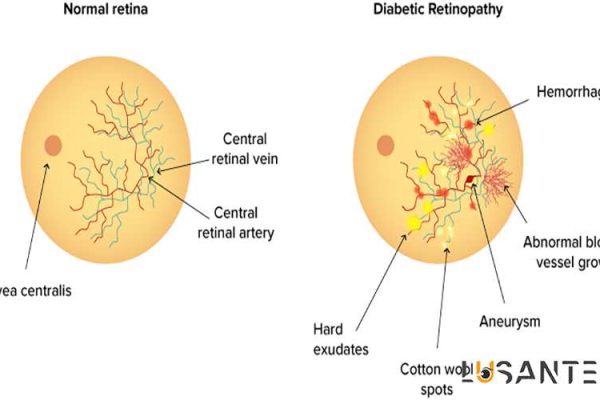
Diabetes And Vision loss; Diabetic retinopathy; Stages of retinopathy
Over time, persistent high blood sugar levels can damage the blood vessels supplying the retina, which is described in 3 main stages:
Diabetes And Vision loss; The first stage of retinopathy
At this stage, small bumps appear in the wall of the blood vessels behind the eye, which may cause a small amount of blood to leak. This stage is very common in people with diabetes.
in this level:
- Vision is not affected, although the risk of future vision problems is increased
- We do not need treatment, but we should prevent the problem from worsening by visiting the doctor regularly
- If both eyes are affected, poor vision is more likely
Diabetes And Vision loss; The second stage of retinopathy
At this stage, more intense and extensive changes, including bleeding in the retina, are seen.
in this level:
- It is possible that vision eventually be affected
- It is recommended to visit an ophthalmologist for an eye examination every 3, 6, 9, or 12 months (depending on the doctor’s opinion).
Diabetes And Vision loss; The third stage of retinopathy
At this stage, new blood vessels and scar tissue are formed on the retina, which can cause significant bleeding and detachment of the retina.
in this level:
- The risk of vision loss is very high (Diabetes And Vision loss)
- Treatment is aimed at stabilizing vision as much as possible, although it is not feasible to restore lost vision
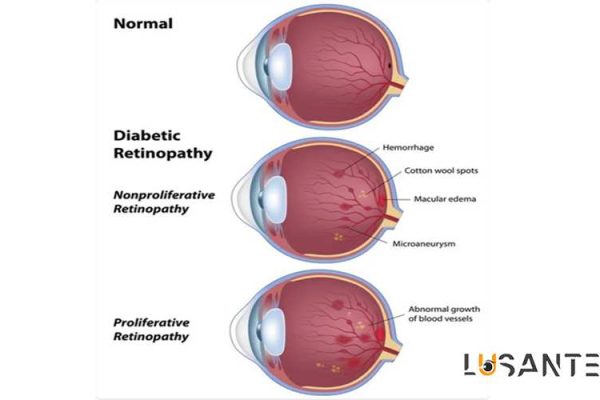
Diabetes And Vision loss; Diabetic maculopathy
In some cases, blood vessels in a part of the eye called the macula (the central area of the retina) can leak or become blocked, which is called diabetic maculopathy. In this case, vision may be affected.
Common Question: Are we at risk of diabetic retinopathy?
Anyone with type 1 or type 2 diabetes is potentially at risk of developing diabetic retinopathy.
This risk is greater in the following cases:
- Have diabetes for a longer period
- The level of blood sugar (blood glucose) is constantly high
- high blood pressure
- high cholesterol
- being pregnant
Therefore, by controlling blood sugar, blood pressure, and cholesterol levels, we can reduce the chances of developing diabetic retinopathy.







